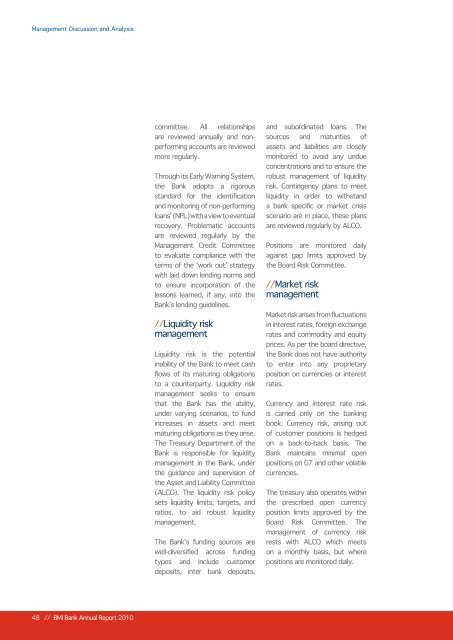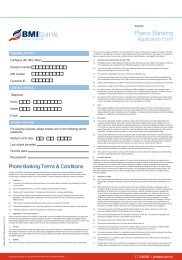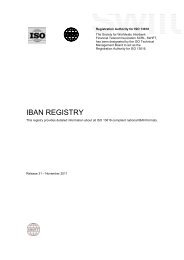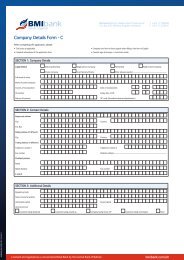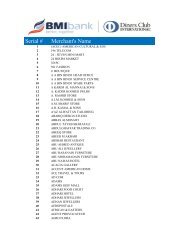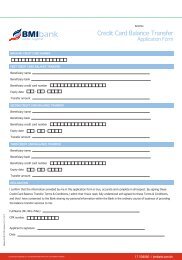English - BMI Bank
English - BMI Bank
English - BMI Bank
You also want an ePaper? Increase the reach of your titles
YUMPU automatically turns print PDFs into web optimized ePapers that Google loves.
Management Discussion and Analysis<br />
Management Discussion and Analysis<br />
committee. All relationships<br />
are reviewed annually and nonperforming<br />
accounts are reviewed<br />
more regularly.<br />
Through its Early Warning System,<br />
the <strong>Bank</strong> adopts a rigorous<br />
standard for the identification<br />
and monitoring of non-performing<br />
loans’ (NPL) with a view to eventual<br />
recovery. Problematic accounts<br />
are reviewed regularly by the<br />
Management Credit Committee<br />
to evaluate compliance with the<br />
terms of the ‘work out’ strategy<br />
with laid down lending norms and<br />
to ensure incorporation of the<br />
lessons learned, if any, into the<br />
<strong>Bank</strong>’s lending guidelines.<br />
//Liquidity risk<br />
management<br />
Liquidity risk is the potential<br />
inability of the <strong>Bank</strong> to meet cash<br />
flows of its maturing obligations<br />
to a counterparty. Liquidity risk<br />
management seeks to ensure<br />
that the <strong>Bank</strong> has the ability,<br />
under varying scenarios, to fund<br />
increases in assets and meet<br />
maturing obligations as they arise.<br />
The Treasury Department of the<br />
<strong>Bank</strong> is responsible for liquidity<br />
management in the <strong>Bank</strong>, under<br />
the guidance and supervision of<br />
the Asset and Liability Committee<br />
(ALCO). The liquidity risk policy<br />
sets liquidity limits, targets, and<br />
ratios, to aid robust liquidity<br />
management.<br />
The <strong>Bank</strong>’s funding sources are<br />
well-diversified across funding<br />
types and include customer<br />
deposits, inter bank deposits,<br />
and subordinated loans. The<br />
sources and maturities of<br />
assets and liabilities are closely<br />
monitored to avoid any undue<br />
concentrations and to ensure the<br />
robust management of liquidity<br />
risk. Contingency plans to meet<br />
liquidity in order to withstand<br />
a bank specific or market crisis<br />
scenario are in place, these plans<br />
are reviewed regularly by ALCO.<br />
Positions are monitored daily<br />
against gap limits approved by<br />
the Board Risk Committee.<br />
//Market risk<br />
management<br />
Market risk arises from fluctuations<br />
in interest rates, foreign exchange<br />
rates and commodity and equity<br />
prices. As per the board directive,<br />
the <strong>Bank</strong> does not have authority<br />
to enter into any proprietary<br />
position on currencies or interest<br />
rates.<br />
Currency and interest rate risk<br />
is carried only on the banking<br />
book. Currency risk, arising out<br />
of customer positions is hedged<br />
on a back-to-back basis. The<br />
<strong>Bank</strong> maintains minimal open<br />
positions on G7 and other volatile<br />
currencies.<br />
The treasury also operates within<br />
the prescribed open currency<br />
position limits approved by the<br />
Board Risk Committee. The<br />
management of currency risk<br />
rests with ALCO which meets<br />
on a monthly basis, but where<br />
positions are monitored daily.<br />
//Interest rate risk<br />
management<br />
Interest rate risk is the risk that<br />
the <strong>Bank</strong>’s profitability or fair<br />
value of its financial instruments<br />
will be adversely affected by the<br />
changes in interest rates. Interest<br />
rate risk arises from the possibility<br />
of changes in interest rates<br />
and mismatches or gaps in the<br />
amount of assets and liabilities<br />
and off balance sheet items that<br />
mature or are re-priced in a given<br />
period. The responsibility for<br />
interest rate risk management<br />
rests with the <strong>Bank</strong>’s ALCO which<br />
takes an integrated view of the<br />
interest rate risk across the <strong>Bank</strong>’s<br />
products and lines of business.<br />
Positions are monitored daily to<br />
ensure they are maintained within<br />
established limits.<br />
//Operational risk<br />
management<br />
Operational risk is the risk of loss<br />
arising from causes associated<br />
with the <strong>Bank</strong>’s processes,<br />
personnel, information systems<br />
and external factors such as those<br />
arising from legal and regulatory<br />
requirements. It is inherent in<br />
every business organization and<br />
covers a wide spectrum of issues.<br />
The objective of the <strong>Bank</strong> is to<br />
manage this risk by striking a<br />
commercial balance between the<br />
risk of financial loss and avoiding<br />
excessively bureaucratic internal<br />
procedures which limit the ability<br />
to provide an effective service<br />
to customers. The <strong>Bank</strong> achieves<br />
this through a control-based<br />
environment where processes<br />
are documented, authorization is<br />
independent and transactions are<br />
monitored and reconciled. This<br />
is supported by an independent<br />
program of periodic internal audit<br />
reviews.<br />
Operational risk management<br />
process is guided by high level<br />
policies supported by procedures<br />
embedded within the policies.<br />
The policies and the procedures<br />
captures how the <strong>Bank</strong> manages<br />
its operational risk by identifying,<br />
controlling and mitigating the<br />
operational risk and implementing<br />
any additional procedures which<br />
may be required as dictated by<br />
the risk identified or operational<br />
risk loss incurred. The operational<br />
risk processes and procedures<br />
are dictated by the scale of<br />
operations.<br />
The Operational risk management<br />
regime is guided by the following<br />
principles:<br />
• Management of operational<br />
risk is the responsibility of the<br />
senior management of each<br />
segment of business.<br />
• Appropriate and regular<br />
management reports.<br />
• Risk assessment of critical<br />
businesses to identify risks<br />
facing each department<br />
and the risks inherent in its<br />
processes and products.<br />
Risks identified are subjected<br />
to periodic reviews to ensure<br />
that the circumstances under<br />
which they were identified<br />
have not significantly changed.<br />
• Collection of operational<br />
risk loss data and reporting<br />
individual cases and trends to<br />
senior management.<br />
48 // <strong>BMI</strong> <strong>Bank</strong> Annual Report 2010<br />
<strong>BMI</strong> <strong>Bank</strong> Annual Report 2010 // 49


